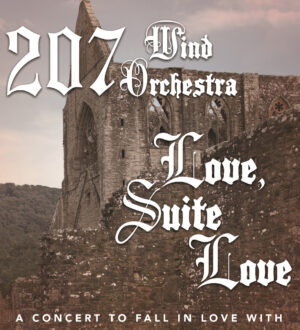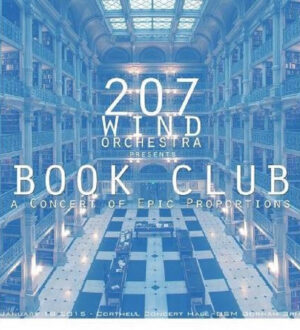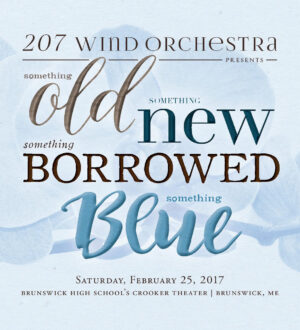Description
Recorded live June 23, 2017 Corthell Concert Hall, University of Southern Maine Timothy Burns, conductor Tim Bathras, recording engineer Michael Burns, cover art Petite Symphonie, Charles Gounod (1818 - 1893) Adagio, allegro Andante cantabile Scherzo (Allegro moderato) Finale (Allegretto) Symphony No. 2, Frank Ticheli (b. 1958) Shooting Stars Dreams Under a New Moon Apollo Unleashed Ascendant, an Astrological Symphony of the Stars, Timothy Burns (b. 1987) T - Cancer Rising J - Autumn Scherzo R - The Faerie’s Harp G - The Great Fugue Symphony for Band (Symphony no. 6), Vincent Persichetti (1915 - 1987) Adagio - Allegro Adagio sostenuto Allegretto Vivace
Piccolo
Nicole J. Rawding
Flute
Karina Carlsson
Diana McNulty
Oboe
Billie Jo Brito
Jennifer Maillet
English Horn
Billie Jo Brito
Bassoon
Emily Olmstead
Linda Soares
Chris Szustak
Contrabassoon
Chris Szustak
E-Flat Clarinet
Nina Andersen
Clarinet
Nina Andersen
Sandy Barry
Julie Cross
Jordan Dube
Ben Fox
Carol Furman
Laura Manduca
Ellen Rust
Jean Quinn
Alto Clarinet
Loren Peters
Bass Clarinet
Jean Quinn
Contralto Clarinet
Loren Peters
Soprano Saxophone
Cara Kinney
Alto Saxophone
Cara Kinney
John Secunde
Tenor Saxophone
Blaise Spath
Baritone Saxophone
Jayne Sawtelle
Trumpet/Cornet
Thomas Kremser
Dan Laciano
Alex Quinn
Max Richardson
Sarah Sukeforth
Horn
Jocelyn Carr
Connie Plaisted
Paul Thomas
John Wheeler
Trombone
Owen Doane
John Sullivan
Bass Trombone
Tim Bathras
Euphonium
Tim Clement
George Wiese
Tuba
Joshua LaChance
String Bass
Joshua DeScherer
Percussion
Mark Fredericks
Eric Landau
Jenna Nelson
Rusty Quinn
The premiere of Gounod’s Petite Symphonie for nine winds (1885) was the result of a particular convergence of circumstances. The first contributing factor was Theobald Boehm’s revolutionary improvements to the structural design of woodwind instruments. Boehm re-imagined the mechanism of these instruments so that they could be built with ideal acoustical properties in mind. These advances improved projection of tone, stability of intonation, and technical facility in addition to bringing woodwind instruments to a standard of consistency that string instruments had achieved centuries prior. The second factor contributing to the premiere of the Petite Symphonie was the concurrent resurgence of wind music as championed by flutist Paul Taffanel. Taffanel founded the Société de Musique de la Chambre pour Instruments à Vent (Chamber Music Society for Wind Instruments) in 1879 to commission and promote music for the newly-perfected Boehm-style woodwind instruments. He reached out the several belle époque composers for new woodwind works, and Gounod responded with the Petite Symphonie. The work calls for the standard Mozart serenade instrumentation of two oboes, two clarinets, two bassoons, and two horns, but Gounod also included a single flute part for Taffanel. The resulting four-movement work exhibits a Classical clarity of form and phrase structure with shades of Romantic harmony and expressivity.
The first movement uses a slow introduction, like that of Haydn, and an Allegretto in sonata form. The second movement features the added flute part. The scherzo that follows is based on a hunting theme, with a lively finale in the fourth movement to end the symphony.
Charles Gounod was a French composer (born on 17 June 1818 in Paris; died on 18 October 1893 in Saint-Cloud). His father was a painter and his mother a pianist. During his youth he studied harmony and counterpoint with Antoine Reicha and eventually studied at the Paris Conservatory. In 1837 Gounod finished in second place for the Prix de Rome but won the award two years later. This prize allowed him to study for two years in Rome as well as Austria and Germany. During this time he met Mendelssohn who would influence him compositionally. In 1843 his mother arranged for Charles to work at a church. Through out the early part of his life he debated entering the priesthood. His music gained prominence in the 1850s through opera commissions. Gounod’s most influential works include his numerous masses, the opera Faust (1859), and the piano piece Funeral March of a Marionette (1873).
The three movements titles in Ticheli’s Symphony No. 2 refer to celestial light — Shooting Stars, the Moon, and the Sun.
Although the title for the first movement, “Shooting Stars,” came after its completion, I was imagining such quick flashes of color throughout the creative process. White-note clusters are sprinkled everywhere, like streaks of bright light. High above, the Eb clarinet shouts out the main theme, while underneath, the low brasses punch out staccatissimo chords that intensify the dance-like energy. Fleeting events of many kinds are cut and pasted at unexpected moments, keeping the ear on its toes. The movement burns quickly, and ends explosively, scarcely leaving a trail.
The second movement, “Dreams Under a New Moon,” depicts a kind of journey of the soul as represented by a series of dreams. A bluesy clarinet melody is answered by a chant-like theme in muted trumpet and piccolo. Many dream episodes follow, ranging from the mysterious, to the dark, to the peaceful and healing. A sense of hope begins to assert itself as rising lines are passed from one instrument to another. Modulation after modulation occurs as the music lifts and searches for resolution. Near the end, the main theme returns in counterpoint with the chant, building to a majestic climax, then falling to a peaceful coda. The final B-flat major chord is colored by a questioning G-flat.
The finale, “Apollo Unleashed,” is perhaps the most wide-ranging movement of the symphony, and certainly the most difficult to convey in words. On the one hand, the image of Apollo, the powerful ancient god of the sun, inspired not only the movement’s title, but also its blazing energy. Bright sonorities, fast tempos, and galloping rhythms combine to give a sense of urgency that one often expects from a symphonic finale. On the other hand, its boisterous nature is also tempered and enriched by another, more sublime force, Bach’s Chorale BWV 433 (Wer Gott vertraut, hat wohl gebaut). This chorale — a favorite of the dedicatee, and one he himself arranged for chorus and band — serves as a kind of spiritual anchor, giving a soul to the gregarious foreground events. The chorale is in ternary form (ABA’). In the first half of the movement, the chorale’s A and B sections are stated nobly underneath faster paced music, while the final A section is saved for the climactic ending, sounding against a flurry of 16th-notes.
My second symphony is dedicated to James E. Croft upon his retirement as Director of Bands at Florida State University in 2003. It was commissioned by a consortium of Dr. Croft’s doctoral students, conducting students and friends as a gesture of thanks for all he has given to the profession.
– Frank Ticheli
Frank Ticheli (b. 1958) is an American composer and conductor. His music has been described as being “optimistic and thoughtful” (Los Angeles Times), “lean and muscular” (New York Times), “brilliantly effective” (Miami Herald) and “powerful, deeply felt crafted with impressive flair and an ear for striking instrumental colors” (South Florida Sun-Sentinel). Ticheli (b. 1958) joined the faculty of the University of Southern California’s Thornton School of Music in 1991, where he is Professor of Composition. From 1991 to 1998, Ticheli was Composer in Residence of the Pacific Symphony, and he still enjoys a close working relationship with that orchestra and their music director, Carl St. Clair.
Ticheli is well known for his works for concert band, many of which have become standards in the repertoire. In addition to composing, he has appeared as guest conductor of his music at Carnegie Hall, at many American universities and music festivals, and in cities throughout the world, including Schladming, Austria, at the Mid-Europe Music Festival; London and Manchester, England, with the Meadows Wind Ensemble; Singapore, with the Singapore Armed Forces Central Band; and numerous cities in Japan, with the Bands of America National Honor Band.
Frank Ticheli is the winner of the 2006 NBA/William D. Revelli Memorial Band Composition Contest for his Symphony No. 2. Other awards for his music include the Charles Ives and the Goddard Lieberson Awards, both from the American Academy of Arts and Letters, the Walter Beeler Memorial Prize, and First Prize awards in the Texas Sesquicentennial Orchestral Composition Competition, Britten-on-the-Bay Choral Composition Contest, and Virginia CBDNA Symposium for New Band Music.
Frank Ticheli received his doctoral and masters degrees in composition from The University of Michigan. His works are published by Manhattan Beach, Southern, Hinshaw, and Encore Music, and are recorded on the labels of Albany, Chandos, Clarion, Klavier, Koch International, and Mark Records.
Ascendant, an Astrological Symphony of the Stars is a work based on the astrology charts of myself and 4 good friends. After having these friends discuss the inner workings of astrology as an art, I got to thinking – there are 12 pitches in a chromatic scale and 12 signs in astrology. So I took the 5 charts and got pitch material then tried to make each section really bring out the character of these people.
T – Cancer Rising
This is an autobiographical movement. I use the tones that were given to me in the order they appear to emulate some of my favorite composers – Bartok, Shostakovich, Prokofiev, and even a little Strauss. The buildup and explosion very much sounds like I do if I were to get very angry. While I’ve worked hard to cull this anger, every now and again it rears it’s ugly head – of course in the style of Shostakovich.
J – Autumn Scherzo
J is a dear friend who is not as tall as some and has fiery red hair. She often wears green and brown and is a trained dancer. Her sprightly character and love of “tongue-clicks” make an appearance in this scherzo. The pitches again come in the order they were given, and the bass line and harmonies are all just re-organizations of the same pitches.
R – The Faerie’s Harp
R stands for the last name of two of my favorite people. They are the type of people that you can go sit in a room with for 3 hours and have no plans but still have the time of your life doing…well nothing. They are firm believers in the Mystic, and as such their charts gave wonderful material to work with. One sister’s chart had only 6 notes total. I organized these 6 notes into 2 3-note chords, which alternate back and fourth slowly, while the other sister’s tone-row is all the other melodic material.
G – The Great Fugue
G commissioned this work and asked for a symphony that used the same instrumentation as Peter and the Wolf. This last movement describes him more than I could have possibly hoped. A grand fugue opens with the tenor voices, lead by the trombone – his instrument. This man, who at the time was a mere 23 years old, could easily have been mistaken for a mid-40s college professor. He regularly plays the organ, so I’ve asked the orchestra to sound as an organ while playing this fugue that at times is Hindemith, Beethoven, Bach, and Burns. A build to a great finale in F major quickly turns very chromatic as the “organist” slams down their fists on any note they want before yielding to a unison F.
The Symphony for Band was commissioned and premiered by Clark Mitze and the Washington University Band at the MENC Convention in St. Louis on April 16, 1956. According to the composer, it could have been titled Symphony for Winds, following, as it did, his Symphony No. 5 for Strings. Persichetti, however, did not wish to avoid the word “band,” which he felt no longer had the connotation of a poor quality of music. In the autumn 1964 Journal of Band Research, he wrote, “Band music is virtually the only kind of music in America today (outside of the ‘pop’ field) which can be introduced, accepted, put to immediate and wide use, and become a staple of the literature in a short time.” According to Jeffrey Renshaw, “The Symphony for Band…was in many ways such a departure from the established concepts of band works that it influenced the attitudes of generations of composers.”
The four movements (Adagio allegro, Adagio sostenuto, Allegretto, and Vivace) have forms with traditional implications. The opening horn call and a following scale-wise passage in the slow introduction become the two principal themes (in reverse order) in the subsequent Allegro. The standard exposition, development, and recapitulation of sonata form are the Allegro, although the traditional key relationships are not completely retained. The slow second movement is based on “Round Me Falls the Night,” from the composer’s Hymns and Responses for the Church Year. The third movement, in trio form, serves as the traditional dance movement and is followed by a finale in free rondo form, which draws the thematic material from the preceding movements and concludes with a chord containing all 12 tones of the scale.
– Program Note from San Luis Obispo Wind Orchestra concert program, March 2, 2010
Vincent Persichetti (6 June 1915, Philadelphia (Penn.) – 14 August 1987, Philadelphia) was an American composer and educator.
Persichetti began his musical life at a young age, first studying the piano, then the organ, double bass, tuba, theory, and composition. By the age of 11 he was paying for his own musical education and helping by performing professionally as an accompanist, radio staff pianist, church organist, and orchestra performer. At the age of 16 he was appointed choir director for the Arch Street Presbyterian Church in Philadelphia, a post he would hold for the next 20 years. During all of this, Persichetti was a student in the Philadelphia public schools and received a thorough musical education at the Combs College of Music, where he earned a degree in 1935 under Russel King Miller, his principal composition teacher.
Starting at the age of 20, he was simultaneously head of the theory and composition departments at the Combs College, a conducting major with Fritz Reiner at the Curtis Institute, and a piano major with Olga Samaroff at the Philadelphia Conservatory. He received a Diploma in Conducting from the Curtis Institute and graduate degrees from the Philadelphia Conservatory. In 1941 Persichetti married Dorothea Flanagan, a pianist he met while a graduate student, who bore him a son and a daughter. In 1947 he joined the faculty of the Juilliard School of Music, and became the chairman of the Composition Department in 1963.
Persichetti composed for nearly every musical medium, with more than 120 published works. Although he never specifically composed “educational” music, many of his smaller pieces are suitable for teaching purposes. His piano music, a complete body of literature in itself, consists of six sonatinas, three volumes of poems, a concerto and a concertino for piano and orchestra, serenades, a four-hand concerto, a two-piano sonata, twelve solo piano sonatas, and various shorter works. His works for winds rank as some of the most original and well-crafted compositions in the medium, and his Symphony No. 6 is rightly considered one of the “cornerstones” of the genre.





Reviews
There are no reviews yet.